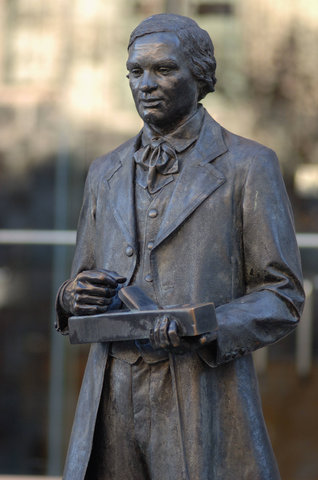Thomas Day
 by LeRae Umfleet
by LeRae Umfleet
Research Branch, NC Office of Archives and History
https://www.dncr.nc.gov/about-us/history/division-historical-resources/nc-highway-historical-marker-program
See also: Thomas Day for K-8 students
Thomas Day, a cabinetmaker by trade, is the most celebrated of North Carolina’s antebellum craftsmen. He was born in Dinwiddie County, Virginia, in 1801 to a family of free, landowning African Americans. His father, John Day, was a skilled cabinetmaker who plied other trades, as well, but always relied on woodworking to bring in money. Thomas and his brother John were well educated. John’s education, boarding with prominent whites and attending their schools, is documented in his later correspondence; it is assumed that Thomas was offered the same opportunities. Both of the Day sons followed in their father’s footsteps initially, learning the skills of a cabinetmaker. John Day eventually left the trade to study theology and later moved to Liberia, becoming one of its founders by signing their Declaration of Independence.
John Day moved to Warren County by 1820 and it is believed that Thomas was with him. Thomas Day and his brother had established themselves in the furniture business in Milton by 1823. Thomas Day became a prominent and well-respected citizen of the community. In response to an act of 1826 that prohibited free blacks from immigrating into the state, Milton’s white leaders petitioned the General Assembly in 1830 to allow Day’s bride, Aquilla Wilson, a free black person from Virginia, to join her husband in North Carolina. They would raise two sons and a daughter. In his almost forty years in Milton, Thomas Day built an extraordinary business, employing freedmen and enslaved people alike to craft stock lines of furniture and to fill custom orders for furniture and interior woodworking. By 1850, Day had the largest cabinetry shop in North Carolina. He is believed to have died in about 1861, after having suffered financial losses due to the national panic of 1857. The extant examples of his work are tangible evidence of Thomas Day’s accomplishments.
Educator Resources:
Grades K-8: https://www.ncpedia.org/thomas-day-k-8
References:
Marshall, Patricia Phillips, and Jo Ramsay Leimenstoll. 2010. Thomas Day: master craftsman and free man of color. Chapel Hill: Published in association with the North Carolina Museum of History by the University of North Carolina Press.
Rodney D. Barfield, “Thomas and John Day and the Journey to North Carolina,” North Carolina Historical Review (January 2001): 1-31
Patricia Phillips Marshall, "The Legendary Thomas Day: Debunking the Popular Mythology of an African American Craftsman,” North Carolina Historical Review (January 2001): 32-66
Powell, William Stevens. 1986. Dictionary of North Carolina biography. Vol. 2, D-G. Chapel Hill: University of North Carolina Press. http://www.netlibrary.com/urlapi.asp?action=summary&v=1&bookid=47800.
2 August 2010 | Umfleet, LeRae